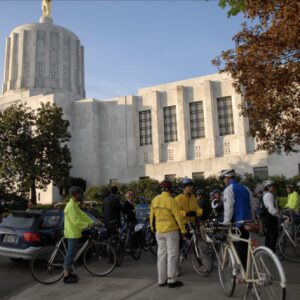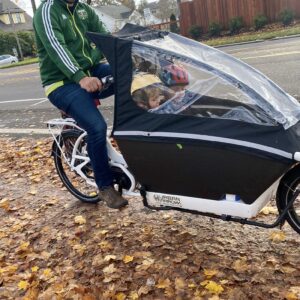As bike ridership spikes in cities across the state, Oregon’s upcoming legislative session is sure to be full of bike-related action. Figuring prominently in that mix will be the lobbying efforts of the Portland-based Bicycle Transportation Alliance (BTA).
Leading the charge for the BTA will be their new Government Affairs (a.k.a. lobbyist) man Karl Rohde. Today I learned more about what Rohde and the BTA might be focusing on in January when Oregon’s 75th Legislative Assembly convenes in Salem.

(Photo © J. Maus)
As I reported back in June, the BTA will work to pass a vehicular homicide bill. Other legislative issues currently under consideration by the BTA include efforts to; bolster driver’s education, bring transportation costs into the funding decision when new schools are built, make crash report forms more bike and pedestrian friendly, and an effort to re-frame how Oregon perceives the need for bike and pedestrian funding.
Of all their possible legislative ideas, the Vehicular Homicide Bill is the most developed at this point. Rohde says the BTA wants to increase the penalties drivers face when they kill a vulnerable roadway user. The draft language of the bill states that someone could be found guilty of a Class C felony (punishable by maximum 5 years prison sentence and $125,000 fine) if the person was driving without a license, driving with a suspended license, driving without insurance, or if “the person’s ability to safely operate the vehicle was impaired”.
The bill defines “impaired” as anything that “materially diminishes” the safe operation of the vehicle such as; the use of drugs or alcohol, the use of a cell phone or other device, or any condition (such as sleep deprivation) that “negatively affects the person’s sensory perception and reaction time.”
Another area where the BTA wants to get tough is with driver’s education. Saying that they recognize a “serious problem” with current driver’s testing standards in Oregon, Rohde says they’ll push for tougher driver training, more bike and pedestrian-related questions on the driver’s test and more knowledge of laws required before licenses are renewed.
(As for licensing bike operators, Rohde says they’ve got no official plans to pursue the idea but they’re doing research on it and they hope to have a white paper on the subject by November.)
Dovetailing with their ongoing Safe Routes to Schools efforts, the BTA will seek to amend an existing law that dictates how school administrators decide where to build new facilities. Currently, there is no requirement to figure in transportations costs when making that decision and the BTA feels that leads to schools being built in locations that are not easily accessible by biking and walking.
Further seeking to level the playing field with motor vehicles, the BTA will also work to make a few minor changes to Oregon’s Traffic Accident and Insurance Report form. The idea is to make sure the forms include language for involved parties that might have been operating something other than a motor vehicle. Rohde says the existing forms “allow for bike reporting, but the wording tends to make it sound like it’s just for drivers”. These changes will be accompanied by an effort to encourage more non-motorized vehicle operators to file crash reports.
Also in 2009, the BTA is expected to try and re-frame how Oregon lawmakers perceive funding for bike and pedestrian projects. Similar to what Congressman Earl Blumenauer is doing with his National Bike Bill (a resolution which passed the U.S. House back in May), Rohde says the BTA will seek to pass a resolution that recognizes funding for non-motorized projects as an essential part of a complete transportation system. According to Rohde, he wants bikes and peds to be thought of as “non-motorized transportation” and bike and ped facilities not be considered “trails” (a common wording that makes them seem like a frivolous expenditure in hard times) but rather as “non-motorized transportation corridors”.
Rohde says the idea is not to simply have lawmakers use different language, but to drive home the idea that, when drafting any transportation funding, lawmakers look for ways to fund bike and ped projects “every step of the way”.
Noticeably absent from this list is any effort to move forward with an “Idaho-style” stop sign law. In Idaho, bicycles are allowed to (when safe) treat stop signs as yields. The idea was raised by Senator Floyd Prozanski (D-Eugene) in the Oregon legislature back in 2003. It passed the House and, once word spread to the media, it failed to pass the Senate. Last session, a citizen-led effort garnered a bit of support, but it was never considered in committee.
The BTA has discussed the “stops as yields” issue internally, but at this point, they have no official plans to move forward with it.
Stay tuned for more details on the BTA’s legislative efforts, along with full coverage of the 2009 session.






Thanks for reading.
BikePortland has served this community with independent community journalism since 2005. We rely on subscriptions from readers like you to survive. Your financial support is vital in keeping this valuable resource alive and well.
Please subscribe today to strengthen and expand our work.
Is it me, or does:
The bill defines “impaired” as anything that “materially diminishes” the safe operation of the vehicle such as; the use of drugs or alcohol, the use of a cell phone or other device, or any condition (such as sleep deprivation) that “negatively affects the person’s sensory perception and reaction time.”
seem overly broad? I’m not a lawyer, so I’m asking a serious question. a.O?
Good question. There is a constitutional doctrine literally called “vagueness” that voids laws when they are so unclear that a person of ordinary intelligence cannot understand what they require. Cyclist, I’m sure you’re of more than merely “ordinary” intelligence. 🙂 Can you tell what the law requires?
I think probably it would pass the test (i.e., not be unconstitutionally vague). The standard of “materially impaired” as some behavior or factor that “negatively affects the person’s sensory perception and reaction time” seems very clear and objective to me. Proving that beyond a reasonable doubt may be difficult in some situations, but the “beyond a reasonable standard” often is difficult to meet. Perhaps you were thinking along those lines.
Compare the standard above to other laws that incorporate the “recklessness” standard (see those threads here on bikeportland) or the standard in the careless driving violation, and I think you will agree that this bill’s standard compares favorably.
Keep in mind, I only do traffic law (and constitutional law) as a hobby, so I shouldn’t be considered an expert. Got any questions on geothermal leasing I can answer? Where’s Rixter when you need him?
Seriously, your field of expertise is geothermal leasing? I’m extremely interested in protecting natural hot springs from degradation resulting from nearby geothermal development. Small world, ain’t it?
No plans to take up the “stops-as-yields” issue? I guess my $260 donation to the BTA just went to the Portland Police.
Seriously, this needs to be taken up and not dropped because the media “cracked on it” to increase their ratings. The BTA cannot fold like a bunch of Congressman when encounted with resistance. Develop a good story. Relate the issue to the legislature and make it happen. How many years have we been asking for this? To me, this is issue number 1.
Unbelievable.
a.O: I was just thinking of all the conditions a person might be in that might negatively affect their attention span… someone might be preoccupied because a baby is crying in the back seat, tired after coming off a 12 hour shift, worried because their wife is headed into surgery, drunk after an all-night bender. Couldn’t any of the above affect someone’s reaction time?
Proving someone is driving under the influence is easy because we have hard-and-fast rules about what that means (.08 bac, I imagine even trace amounts of drugs), but anything beyond that seems to me to be harder to prove. Even with sleep deprivation, unless someone is asleep at the wheel, how sleepy must one be for the accident to turn into a felony?
I don’t intend to be purposefully obtuse, I just feel a bit uncomfortable with the wording in the proposed legislation. On the other hand if we have a similar standard for other laws, then it makes sense to be consistent.
Can you be “immaterially impaired”? Why qualify impaired? It sounds like a wiggle word purposely inserted to give DA’s a way of not prosecuting because of car-head.
I see your point cyclist. I would need to review the wording of the bill, but I believe the driver would have to do someting that would cause material impairment, such as drinking or taking drugs or taking on a phone. Practically speaking, I agree a DA is unlikely to be able to prove that someone was “materially impaired” because they were tired – as you say, how do you measure how tired?
So this law will probably never be used to prosecute someone who was tired. It will be used to prosecute someone whose blood work comes back showing they were likely impaired, just as is done with the DUI law. In the case of DUI, this is just an enhancement of the penalty – instead of being prosecuted for reckless driving (a misdemeanor), you’d get this felony.
I can’t speak for BTA, but I think the reason the wording was expanded to “materially impaired” was to capture the other easily measurable culprit – talking on the phone. You can often prove that with phone records.
I think the vicissitudes of this aspect are minor in the overall scheme and the important point is that you can use this law to prosecute someone who isn’t licensed to drive or insured.
John-
Really? Issue #1 has to do with your ability to roll a stop sign? That is more important than a bill that might save countless cyclist lives (Vehicle Homicide Bill)? Which, incidentally, may be a factor that could help save a cyclists’ life as they roll through a stop sign?
Unbelieveable is the belief that the BTA (underfunded and understaffed, as most non-profits are) should put serious manpower on a topic that truly effects a small portion of the cycling community, rather than a topic that effects almost the entire commumity.
Unbelieveable is that you’d make a statement such as you did.
I retract my last post.
I just realized that John is being sarcastic.
I totally bought it.
a.O wrote: “I think the vicissitudes of this aspect are minor in the overall scheme”
a.O, would that be true if you, or your loved ones “vicissitudes” were spread all over the street?
I don’t get it, Coyote. To clarify, exactly what counts as material impairment beyond driving while intoxicated or driving while on a cell phone is a minor issue compared to getting enacted legislation that allows people who are driving without a license, without insurance, while intoxicated, or while on a cell phone prosecuted for a felony if they injure or kill a vulnerable roadway user. That would be a huge step forward, would address the majority of likely scenarios where that would happen, and perhaps all of them that can be measured objectively enough to stand up as a law. Does that make sense? Is that what you understood I was saying? Perhaps you could clarify what question you’re asking.
a.O, I don’t want a step forward. I want to get it done. I want the law to say: “If you are driving a car and you hit something the size of a human, you have made a mistake. The mistake may not be 100% your fault, but you have part of the responsibility regardless.”
a.O, I really respect what you have accomplished, and what you advocate, but dang it, we are totally willing to crucify gun owners for not locking their guns up, it is time to hold drivers to the same standard.
You’ll get no argument on that from me, Coyote. In fact, I’ll be right there with you fighting for that. There are many Oregon Legislators who do not share those views, that’s the bad news.
The good news is that it’s mostly because they are not aware of the level of carnage caused by motor vehicle operators. If you told most of them that people driving automobiles kill 42,000 Americans each year, they would be surprised. So the good news is that they can be educated and lobbied. Most are reasonable folks who have never thought in great detail about that issue or how and why we need a public policy that encourages bicycling. So, there is definitely room for movement.
But it’s going to take many steps and a lot of work. IMHO, this kind of work is an excellent reason to donate to BTA. Karl Rohde is very knowledgeable about transportation issues and he understands the political realities very well, so he’s a good advocate to have in Salem.
Whenever that number of 42,000 comes up everyone makes it sound like the drivers of these vehicles are walking away unscathed after mowing down cyclists and pedestrians.
So for the sake of accuracy let’s look at the numbers for 2007 from the National Highway Traffic Safety Administration.
Total fatalities 41,059
Passenger Vehicle Occupants 28,933 70.46%
Other Vehicle Occupants 1468 3.57%
Motorcycle Operators 5154 12.55%
Pedestrians 4654 11.33%
Cyclists 698 1.69%
Other/Unknown Non Occupants 152 0.37%
For the full presentation go to http://www.nhtsa.gov and click on “Newest Studies and Reports” from the menu on the left. These numbers came from “2007 Annual Assessment of Motor Vehicle Traffic Crashes Presentation”.
there should be no question that “material impairment” does, yes, include dealing with the crying baby in the backseat, or the spilled coffee or the stray receipt. motorists need to be told that the way to deal with this kind of thing is to pull over and stop the car. if there is any question whether “material impairment” includes this stuff, then the language needs more work. what is wrong with simple words like “inattention” and “distraction”?
woogie (#13) – Thanks for the numbers! This really shows how to relate this kind of thing to the legislature. It’s hard to sell a law that seems to benefit only cyclists or cyclists and pedestrians (we’ll set aside for now the fact that motorists NOT killing cyclists is perceived as “benefitting” cyclists at the expense of motorists). 70.5% of the fatalities are motor vehicle occupants. I think that statistic alone emphasizes both that driving a motor vehicle is dangerous, and that distracted driving laws are necessary (or at least should be incorporated into the existing careless/reckless driving laws). Inattentive or impaired motorists are the primary cause of car “accidents”.
I think the BTA’s got a good set of priorities for this legislative session, and I wish them the best of luck this round. Go Karl!
I’m always amused/befuddled when people clamor to hike up the penalties in serious cases where a victim is killed like vehicular homicide. I realize we need to send a message that cyclists and pedestrians are not just traffic cones. But, I seriously doubt that imposing multi year sentences on individuals guilty of such behavior actually does anything to protect vulnerable road users. When was the last time you asked yourself, “gee, I’d better not speed through that yellow light because I might hit some vulnerable road user and end up in prison for 5 years”? People do stupid, thoughtless things behind the wheel because they’re lazy, ignorant of the consequences or just don’t care. Speeding enforcement, for example, only works when the driver perceives that there’s a reasonable chance of being caught not because he/she sees speeding as dangerous. Enforcement of a vulnerable road user statute will have minimal impact on our safety because drivers really don’t see the remotest possibility that they might hit someone.
Don’t get me wrong, I agree that some sort of stiff penalty is a good thing. But, what we need first and foremost is education, education and more education. That should include mandatory automobile license renewals every 5 years which require some sort of skills and knowledge testing. As we all know, driving a 3000lb vehicle is not a right, it is a privilege.
Ron
not long ago I cut a modest chunk off the end of my thumb with a paring knife because I was used to chopping rather than slicing. immediately I learned my lesson, and now I diligently slice rather than chop. people driving cars need to be jarred into a new awareness that they are operating heavy machinery in an unpredicatable environment. people involved in construction learn to do the hardhats and safety goggles and shoring up this and tying down that.
in short, I disagree that we cannot ever get to a point where a motorist says to herself (ref item 16), “gee, I’d better not speed through the yellow light.” we can get there is we push for it day in and day out and make it the social norm. one way to make it the social norm is to deny privileges to people who do not conform.
no shirt, no shoes, no service.
r.
I agree that recognizing vulnerable users’ rights to the road should (and will some day, I trust) be the social norm. Ultimately, we need to create attitude changes just as we’ve done or are in the midst of doing with drinking and driving. However, I don’t believe that was due for the most part to increased penalties. I feel it was due to increased enforcement (the idea that one might get caught is a stellar reason to avoid doing something stupid) and a constant barrage of advertising in every media about the dangers of driving while impaired.
r.
But by your measure of “no shirts, no shoes, no service”, the lay blame on the driver regardless of the situation doesn’t hold.
Penalize those who don’t follow the rules. Everyone, that includes pedestrians who walk into traffic without looking, cyclists who run traffic control devices.
Anyone who has hit a deer can tell you that you can be the most vigilant driver possible and still be at risk from unpredictable behavior on the part of the animal that you hit. When a cyclist, pedestrian or driver acts in the same unpredictable manner collisions will occur, and to always lay the blame on the driver is not going to enforce your “social norm”, because everyone is not equally required to live by that norm. Where is the incentive for non-drivers to adhere to the “social norm” when they are absolved of any measure of responsibility?
Demanding that we fix a problem by removing discrimination from one group and applying to another isn’t going to work.
As Orwell pointed out “All animals are equal, but some animals are more equal than others”, doesn’t work.
How about a provision in the law that prohibits the police from identifying the absence or presence of equipment or accessories that are neither required nor prohibited? This would prohibit the police from announcing whether or not the cyclist had a helmet (unless it was a child who is required to wear one) and it would also prohibit the police from announcing whether the motorist did or did not have fuzzy dice hanging from his mirror.
It is interesting that most of our legislators having anything to do with passing laws regarding crime and punishment have jumped on the wagon leading to incarceration and public fines for nearly all misdeeds in our good U.S.A. Our prisons are overcrowded already to the point where we are letting those convicted out on the streets. Now, here’s another piece of legislation to add to the prison burden. It is a knee-jerk, reactionary way of dealing with a problem.
The U.S. average cost per inmate is approximately $22,650 per year. We have over 2 million people locked up in prison now. That’s a taxpayer cost of $45,300,000,000.00 per year. (Many, many are in jail on false charges, but we won’t focus on that right now). This does not include the public costs of operating the judicial system when trying all these cases.
DUI’s are way down due to constant enforcement and education via media. Why not do the proactive thing, and forward spend some of the public’s money we’re going to spend for judicial action/incarceration toward enforcement and education in this vital area?
As time passes, I’m becoming more inclined to favor a stop-as-yield law for Oregon. By legalizing the safe practice of coming to an almost-stop when there is no cross-traffic, it would reduce one source of antagonism between cyclists and police.
Blowing through a stop sign at full speed would still be a violation, as it should be. Indeed, I believe changing the law would help focus attention on truly hazardous behaviors.
Cyclists (and all vehicle operators) already have to use judgment… for instance, when it’s not safe to stop for a yellow light or when to take the lane due to roadside debris or other conditions. It is not any more difficult to understand when it is safe to slowly roll through a stop sign… and when it isn’t.
if you like, you can craft a law that says a cyclist who injures someone through inattention is penalized in thus and such a way. fine with me.
but the vulnerable user law makes a reasonable distinction between people who are stumbling around with armed nukes and people who are kicking pebbles.
and actually I agree with the comment (18) that frequence of enforcement is more effective than severity of penalty (especially if the infrequency of the severe penalty is near zero).
if you like, you can craft a law that says a cyclist who injures someone through inattention is penalized in thus and such a way. fine with me.
but the vulnerable user law makes a reasonable distinction between people who are stumbling around with armed nukes and people who are kicking pebbles.
I do not pretend (often) to be perfect, but I have had opportunities to hit deer — and children, also unpredictable — and have managed to avoid them both. it does help to pay attention, which is what the law would require.
and actually I agree with the comment (18) that frequence of enforcement is more effective than severity of penalty (especially if the infrequency of the severe penalty is near zero).
if you like, you can craft a law that says a cyclist who injures someone through inattention is penalized in thus and such a way. fine with me.
but the vulnerable user law makes a reasonable distinction between people who are stumbling around with armed nukes and people who are kicking pebbles.
I do not pretend (often) to be perfect, but I have had opportunities to hit deer — and children, also unpredictable — and have managed to avoid them both. it does help to pay attention, which is what the law would require.
and actually I agree with the comment (18) that frequence of enforcement is more effective than severity of penalty (especially if the infrequency of the severe penalty is near zero).
from article: ‘increase the penalties drivers face when they kill a vulnerable roadway user’
weak, they should not classify a road user this way, if someone kills, maims, destroys another roadway user due to inattention it should not matter if the victim is wrapped in steel or on rollerblades – the perp should face charges regardless
Total fatalities 41,059
Passenger Vehicle Occupants 28,933 70.46%
Other Vehicle Occupants 1468 3.57%
Motorcycle Operators 5154 12.55%
Pedestrians 4654 11.33%
Cyclists 698 1.69%
Other/Unknown Non Occupants 152 0.37%
What I’ hearing is protect 14%, the other 86% don’t matter as much, that sucks if the 70% passenger occupant class happens to be an infant … well it sucks regardless
equal protection for all cage or no cage
Mike,
Thanks for bringing John’s joke to my attention. I was getting really hot at his statement. Underfunded, understaffed and overworked staff is absolutely right.
If all these experts put their two cents in by volunteering for the BTA, as well as become members, they would be a powerhouse of a non-profit. They have worked their butts to the bone bringing as many issues to the table at a time, as they can.
They have my continued support.
Andrew H – your comments mirror my thoughts exactly.